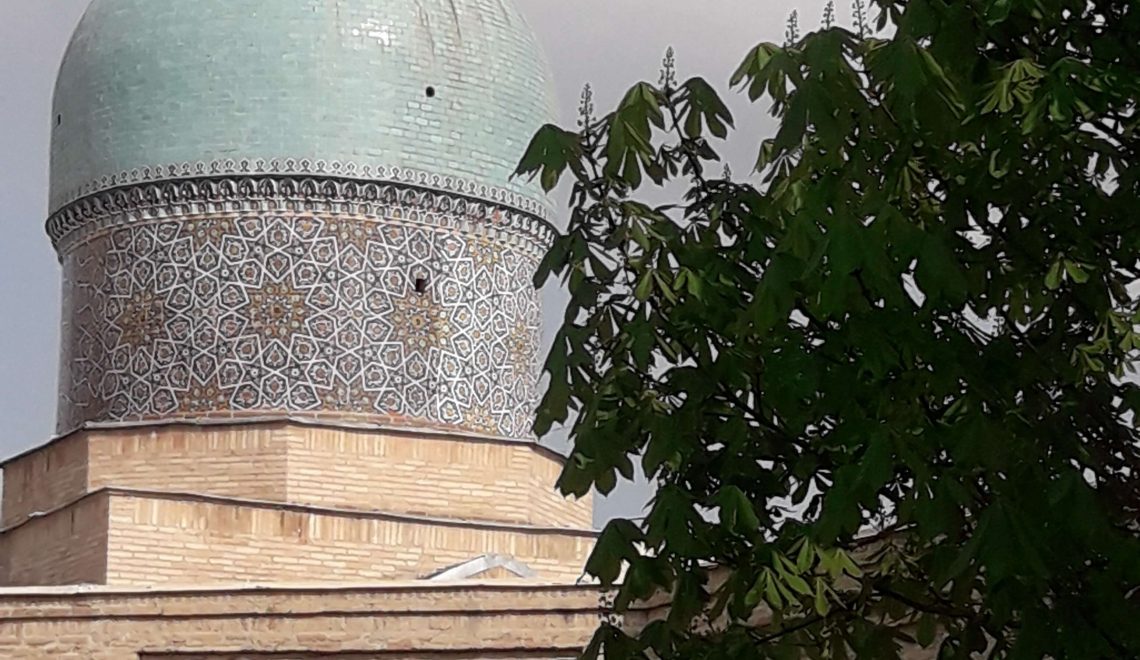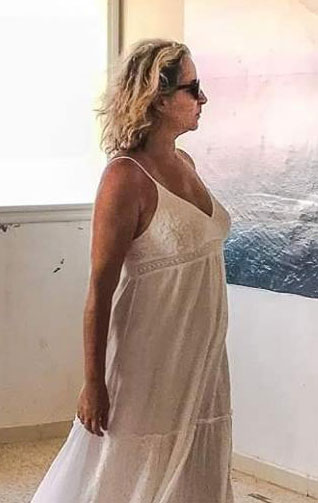
Termez , the hot place – From the Uzbek people, we have a lot to learn: the great respect they show for their heritage, traditions and culture, the love they have for their Uzbekistan, cleanliness, openness and hospitality, sincere and selfless and finally refinement and civility.

I feel fresh out of the pages of an old book of magic and fabulous tales “
One Thousand and One Nights“. It is in this collection of thousand-year-old tales that Shéhérazade invited me to Samarkand, the city on the edge of the worlds, crossroads of cultures and one of the most renowned sites of universal heritage, linked to our Arab imagination to life, art and to the love of the philosopher and poet Omar Al Khayyam as described in the famous novel by Amine Maalouf, who chose it as title and main place where the events took place. Sheherazade introduced me to Tashkent, “stone citadel” with more than two thousand years of history, civilization, culture and contribution to the heritage of humanity, and made me discover Bukhara “the fortunate place “(where were born” achaikh arrais “prince of the scientists and the greatest of the doctors, the third excellent master after Aristotle and Al Fârabi, the doctor, astronomer, psychologist, alchemist, mathematician, philosopher, theologian, musician, poet and politician: Abu Ali Al Hussein Ibn Abdallah Ibn Sina said Avicenna and Imam Mohammad Al Bukhari the famous scholar of the hadith) and Khawarezm “biledou achams” or country of the sun (the city of the famous mathematician Muhammad Ibn Moussa Al Khawarezmi and scholar and philosopher Al Birouni classmate Avicenna and Miskawayh).
The silk road: History
It was at school, during the history lessons, that I learned about the Silk Road “tarik al harir” that once connected Chang’an (in China) to Antioch (the current Antakya in Turkey), through which were transported from East to West and vice versa: silk, paper, spices, glass, jewels, as it allowed music, dance, clothes and the art of cooking to travel through the countries. I still keep a distant memory of my school books where I read the History of Amir Temur (Temerlan or Timur-Lang), Temüjinou Gengis Khan and the dreadful warlord Hulagou Khan (Khulagu or Hülegü qan).

Discovering Termez
I just returned from a trip to Uzbekistan, the country of all this, that is why I feel like I’m leaving the pages of ” One Thousand and One Nights”. I was invited to a Bakhchi music festival, held in the city of Termez, Uzbekistan, on the proposal of the Maqam label led by my friends the Jordanian artist Macadi Nahhas and her husband Soud Allan, who was my traveling companion. One day I received the message from Macadi via Messenger, telling me about this festival and asking if I would be interested to attend. … The message from Macadi was about six lines ending with the word “Tashkent”. I admit that the effect of the word was irresistible, all the magic of the East, its myths, its immense history, the greatness of its buildings with vaults and ornamented domes came to my mind. I immediately thought of the majesty of the cultural and civilizational heritage, its infinite richness and its unique place in the common heritage of humanity. To go to Tashkent and Samarkand was until then only of the order of the imagination. It was like a dream. How to decline an invitation like this? It was impossible, of course. And it is thanks to this charming and inventive couple, Macadi and Soud, that I made this trip of which I have brought you my notes and observations.

About the festival
The festival was held from 5 to 10 April 2019, in the city of Termez “warm place” (also the term Termez recalls that of Thermos in Greek), the city with the hottest climate of all Uzbekistan , with just over 140,000 inhabitants, and located in the south-east of the country just on the border with Afghanistan (the country where the Taliban imposed their rule for a few years, shaken by terrorism, civil and regional wars, perpetual interference, rebellious activities, political instability, trafficking in opium and heroin). It’s like being here in Tunisia, very far from this city and having no connection with it. It would be enough to know that it is the hometown of the fakih and Imam Abu Issa Mohammad Al-Termidhi (Al-Termizi), the compiler of the canonical hadeeth of Sunni Islam, to realize that we have just heard about it at least once or twice and we are not so far away as we imagined.
 The name of the festival is: Bakhshi International Art Festival. Organized under the patronage and with the support of UNESCO, its goal is to safeguard the tradition rooted in the region of Uzbekistan, Turkmenistan and Khorasan, that of “Bakhshi”, which means: narrator, singer and instrumentalist. Bakhshi is the art of telling the traditions, history and heritage of the region. Bakhshi is actually the deformation in Turkish of the Chinese word “po-shih” meaning: scholar.
The name of the festival is: Bakhshi International Art Festival. Organized under the patronage and with the support of UNESCO, its goal is to safeguard the tradition rooted in the region of Uzbekistan, Turkmenistan and Khorasan, that of “Bakhshi”, which means: narrator, singer and instrumentalist. Bakhshi is the art of telling the traditions, history and heritage of the region. Bakhshi is actually the deformation in Turkish of the Chinese word “po-shih” meaning: scholar.
Termez – Details…
The opening was on Friday, April 5, 2019, in an outdoor theater, located in the middle of the city of Termez, just in front of the National Museum, with a folk music, song and dance, which lasted two hours and who traced in an epic form the country’s rich, ancient history, taking up legends, truthful events and scenes of famous battles and celebrating national heroes and emblematic figures. The work was an incredible opportunity for the multicultural, multiethnic and multinational audience to discover the richness and incredible variety of the Uzbek legacy and traditions. It was a marvelous moving fresco, with colorful clothes, musical instruments, tools, utensils, fabrics, sheets, carpets, silhouettes, gestures, movements, dances. , paintings of everyday life, scenes of marriage, birth, battles, mountains, rivers, forests, waves, songs, emotion, gentleness, enthusiasm, strength, tenderness, anger, bliss, pride, benevolence, courage, hospitality and more … We did not need , coming from other countries and speaking other languages, any translation of the meaning of words.
 The force of emotion, and the high degree of humanism and authenticity with which the whole work was charged, were amply enough to make us receive, understand and enjoy this message of peace and love. The foreign guests were impressed by the extreme beauty of this work of art and by the rigor and precision with which it was conceived and represented by the conductor, his musicians, the singers and vocalists using their voices and throats to produce the awesome diphonic singing well known in the region (the famous Khoomeii), the dancers women and men and all the others. The Uzbeks attendees, women, men and children, danced, sang and applauded, all proud to recognize themselves completely in their traditions and customs and in the image of their ancestors that reflected the fresco. They did not hesitate to invite others to dance, because it is their way to welcome and share the joy of life and glee.
The force of emotion, and the high degree of humanism and authenticity with which the whole work was charged, were amply enough to make us receive, understand and enjoy this message of peace and love. The foreign guests were impressed by the extreme beauty of this work of art and by the rigor and precision with which it was conceived and represented by the conductor, his musicians, the singers and vocalists using their voices and throats to produce the awesome diphonic singing well known in the region (the famous Khoomeii), the dancers women and men and all the others. The Uzbeks attendees, women, men and children, danced, sang and applauded, all proud to recognize themselves completely in their traditions and customs and in the image of their ancestors that reflected the fresco. They did not hesitate to invite others to dance, because it is their way to welcome and share the joy of life and glee.
Uzbeks are a very hospitable people. In the street, in Termez or Tashkent, people are smiling and very interested in foreigners. They come to you spontaneously and easily engage the conversation in Uzbek, with some sentences in Russian or sometimes English, asking for your name or the country where you come from or the language you speak, if you like Termez and taking to the end a selfie with you for the memory.
 In the evening everyone is in the street, families, couples, groups of girls or boys, everyone gets dressed and goes out to party, regardless of age. The most enchanting thing is to note that the oldest ladies were the ones who love to dance and have fun. The city was crowded with hundreds of partygoers every night until a late hour. Despite this, the vast streets remained totally clean, there is not a single stain on the ground. Moreover it is the specificity of the two cities that I had the opportunity to visit, Termez, the city of Bakhshi and Tashkent, the capital of Uzbekistan. Everywhere, the streets are very large (much wider than the streets in Tunisia or Paris for example), very well appointed, very clean (I have in my life rarely seen such cleanliness in the West and the East), decorated with four corners by the greenery, the trees and the multicolored tulips. Moreover, when we walk in the street, it is only the smell of flowers or trees that we smell, neither fuels, nor cigarettes, nor pollution. There are no beggars, there are no pickpockets and there is no sign of aggression.
In the evening everyone is in the street, families, couples, groups of girls or boys, everyone gets dressed and goes out to party, regardless of age. The most enchanting thing is to note that the oldest ladies were the ones who love to dance and have fun. The city was crowded with hundreds of partygoers every night until a late hour. Despite this, the vast streets remained totally clean, there is not a single stain on the ground. Moreover it is the specificity of the two cities that I had the opportunity to visit, Termez, the city of Bakhshi and Tashkent, the capital of Uzbekistan. Everywhere, the streets are very large (much wider than the streets in Tunisia or Paris for example), very well appointed, very clean (I have in my life rarely seen such cleanliness in the West and the East), decorated with four corners by the greenery, the trees and the multicolored tulips. Moreover, when we walk in the street, it is only the smell of flowers or trees that we smell, neither fuels, nor cigarettes, nor pollution. There are no beggars, there are no pickpockets and there is no sign of aggression.
The buildings and constructions are imposing, composed of dozens of floors, aligned in a very organized and harmonious way, spaced and painted in different colors. It clearly shows the influence of the neoclassical architectural style inherited from the Soviet era.
We find this trend to greatness, colossality and architectural wealth, also in underground subway stations in Tashkent. The 36 stations of the three lines of the city are at a very great depth underground, so much so that it is said that they can serve as a nuclear shelter. They were built from 1972 to earthquake-resistant standards that can withstand a tremor of 10 on the Richter scale. None of these stations are similar to each other. Each one has an architectural style and a unique decoration. The only thing common to all is the magnificence of the palaces. They are all decorated with marble, granite, cast iron, bronze, bas-reliefs and mosaics. Walls covered with faience, frescoes or paintings. It is indeed in one of the stations of this metro, that I crossed on two tables the couples of known lovers around the world “Leyla wa Majnûn” (the famous Leyla and its crazy Kais) and “Farhad wa Shirine “. Even in the subway of this country, you have the right to a little dream, a little imagination and a lot of culture.
These stations of the Tashkentois metro, are a true work of art, such as museums, they are worth visiting, contemplating and being admired one by one. Clean, bright, bright, quiet and especially very modern, all equipped with display screens and automatic doors. Passengers are very often calm, orderly and respectful. As soon as a woman, whatever her age, gets on the subway, there are immediately two or three gentlemen who give her the place to sit down. And one last remark: there is no homeless person in the underground passages of the metro!
 The population in Uzbekistan is about 32.4 million, with a Muslim majority of 94%, with a literacy rate of 99%, an unemployment rate of 5.8% and a poverty rate of 17.7% (figures of the World Bank in 2015). Agriculture is the most important sector of economic activity with a rate of 38% (Uzbekistan produces cotton, fruit, rice, vines, cereals), followed by the service sector at 35%. % and finally the industry with 26.3% (industrial sectors are mainly mining, petroleum refining, car assembly, agricultural machinery).
The population in Uzbekistan is about 32.4 million, with a Muslim majority of 94%, with a literacy rate of 99%, an unemployment rate of 5.8% and a poverty rate of 17.7% (figures of the World Bank in 2015). Agriculture is the most important sector of economic activity with a rate of 38% (Uzbekistan produces cotton, fruit, rice, vines, cereals), followed by the service sector at 35%. % and finally the industry with 26.3% (industrial sectors are mainly mining, petroleum refining, car assembly, agricultural machinery).
Uzbekistan is a country that resembles us on more than one level: doubly out of two difficult political periods marked by the authoritarian regime (the Soviet period as one of the former Republics of the USSR and the regime of the first President Islam Karimov), knowing for a few years a certain openness, neighbor of country unstable and torn by wars, repeatedly victim of terrorist acts … The Uzbeks also resemble us, Tunisians, in their standard of living and part of their character. They are mainly in the image of my two guides: Abdurahmon Xalmatov (in Termez) and Og’abek-Almaz Baqoyev (in Tashkent): friendly, helpful and extremely sensitive and loyal.
Travel, in general, enables us to see what is in others and then look in the mirror, to better know ourselves and know how to situate ourselves among the peoples and nations of the Earth. Travel enables us, among other things, to discover what is good in the other and want to learn, want to become better.From the Uzbek people, we have a lot to learn: the great respect they show for their heritage, traditions and culture, the love they have for their Uzbekistan, cleanliness, openness and sincere and selfless hospitality and finally refinement and civility.
*Amel Chahed, journalist of public broadcasting. She obtained the Diploma of Advanced Studies in Public and Financial Law and the National Diploma of Audiovisual and Film in the specialty of Writing and Directing. She produces and presents programs on Tunisian Television and Radio since 1995. .


 َAbonnez-vous
َAbonnez-vous

